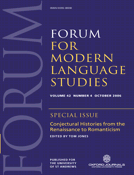-
Views
-
Cite
Cite
A History of Korean Literature. Ed. Peter H. Lee. Cambridge: Cambridge University Press, 2003. lxxiv + 580 pp. £65. ISBN 0–521–82858–9, Forum for Modern Language Studies, Volume 42, Issue 4, October 2006, Pages 463–464, https://doi.org/10.1093/fmls/cql092
Close - Share Icon Share
Extract
This is a thorough introduction to a subject that is little-known outside a highly specialised academic area, and the task of the editor was to make it accessible to the general reader as well as to his colleagues. Professor Lee and his small team of collaborators have succeeded in providing a readable, jargon-free and informative volume that narrates the development of Korean literature from its origins to the late twentieth century. There is an Introduction by the editor, followed by twenty-five chronological chapters, ranging from “Language, forms, prosody and themes” to the literature of North Korea and its socialist-realist celebration of the life and ideology of Kim . There is a strong emphasis on trying to present Korean literature from the perspective of its own culture and traditions and those of its influential neighbours China and Japan, rather than on imposing unhelpful Western categories, such as “epic”, “tragic” or “lyric”, “none of which can be found in East Asia” (p. 13). It is interesting to note, for example, under a discussion of the main themes of the classical, Confucian-dominated literature, that there is little interest in carpe diem, passion or courtship, but rather in the pathos of separation and the rewards of nature and solitude. The book comes with a very helpful fifty-page glossary of literary and technical terms and author names, a thorough bibliography and a dozen illustrations. It is easy to reassure the editor on his goal to make this the standard general work on Korean literature “for more than a decade”.



